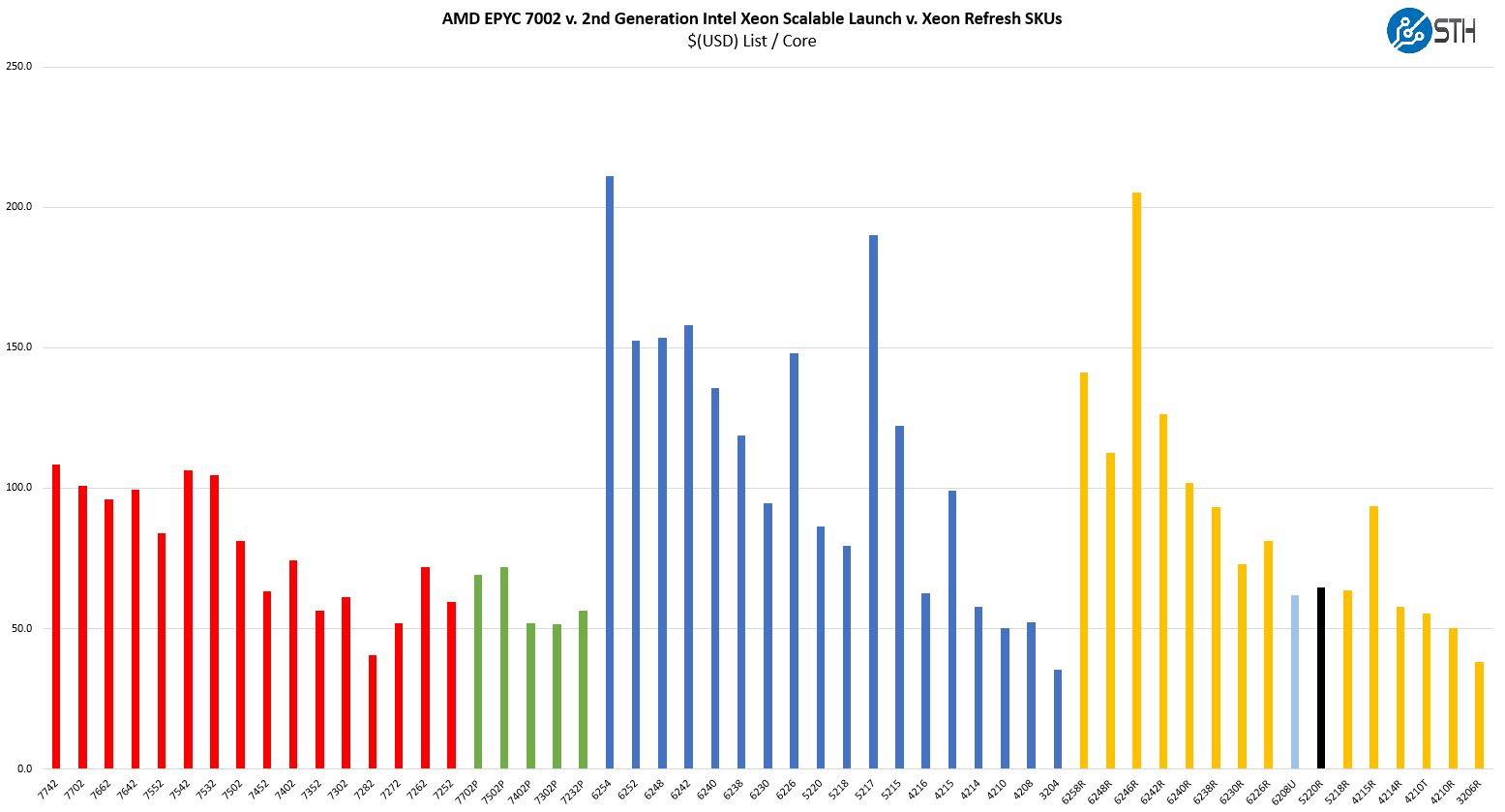Intel Xeon Gold 5220R Market Positioning
Thes chips are not released in a vacuum instead, they have competition on both the Intel and AMD sides. When you purchase a server and select a CPU, it is important to see the value of a platform versus its competitors. Here is a look at the overall competitive landscape:

We are going to dive into the impact of this chart next in our discussion of different competitive vectors.
Intel Xeon Gold 5220R v. Intel Alternatives
Expanding this set again we wanted to take a look at three SKUs in particular, the Intel Xeon Gold 5220R, Gold 5220, and Gold 5120. Those effectively span three generations of processors.

We have a $/core metric which shows we have gone from $111 to $86 and now to 65 per core on a successive basis. Dual-socket capable AMD EPYC 7002 series SKUs average around $75 per core for some context. While the previous two Xeon 5×20 iterations were not competitive on the lower end of the EPYC scale it is clear that the line has been brought that way.
Also when we take raw cores * base frequency (2.2GHz) we go from 30.8 core GHz to 52.8. Since this is largely the same architecture with some minor tweaks, that is why we are seeing a ~70% increase in performance over the Xeon Gold 5120 generation at the same price point.
With more cores and more throughput, it is very hard to recommend the older generation SKUs here.
One item we discussed in detail is a comparison to the Xeon Gold 6226R. We think this is a strong competitor to the Xeon Gold 5220R because it offers fewer cores but at higher clock speeds. For applications such as A Windows Server 2019 Standard 16-core license that is a much better match, and at a lower hardware price as well. As a result, we think this is more for Linux servers that are not running per-core licensed software.
Intel Xeon Gold 5220R v. AMD EPYC 7002 “Rome”
The Xeon Gold 5220R is now in the same range of performance per dollar as the EPYC 7352 and EPYC 7302 but is still behind the 24-core parts. While AMD may have a lead, one also must remember Intel has more components such as NICs and SSDs that can be bundled at a system level with CPUs to offset differences.
Where perhaps the most intriguing deltas happen in this AMD v. Intel segment come down to the platforms. If you are simply adding a few DIMMs and a single SATA SSD to a server with a 10GbE or 25GbE NIC, the platforms do not matter as much. However, we need to take a look at what they offer.
These CPUs support Intel Optane DCPMMs for a different class of persistent memory and storage, albeit only up to 1TB of memory. Intel also has AVX-512 and VNNI (DL Boost) instruction advantages.
AMD has features such as supporting more, higher-capacity, and higher-speed RAM, more PCIe lanes, and PCIe Gen4 support. If you need the more “scalable” two-socket platform, AMD simply has the more scalable dual-socket solution at this point.
Intel also rationalized away a mainstream Cooper Lake Xeon platform so we are left waiting until Ice Lake to get more parity on the platform side.
At the same time, Intel is now thoroughly in the range where with smaller discounts it can offer a competitively performing part, at a close enough price to keep buyers who were considering switching. For incumbents, pricing for your offerings just needs to be “close enough” to avoid a mass exodus to your upstart competitor. Competition is back.
Final Words
If you have been an Intel Xeon Gold 5100 or Gold 5200 buyer, it is hard to recommend the older generation parts. We think this market has consolidated around the Xeon Gold 5220R, Gold 5218R, and Gold 6226R in this price range.
From a competitive standpoint, this is probably about where Intel needs to be. It does not need to be lower than AMD for chips because it can offer a platform to larger customers.
What is clear is that the Intel Xeon Gold 5220R offers a massive performance per dollar upgrade depending on where you set your goalposts. One may say it is a 40% gain or even a 70%+ gain in performance per dollar versus previous generations. That is an enormous move and a benefit of competition.
Overall, this is a chip we think a lot of our readers will be very interested in.



